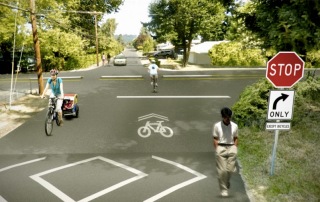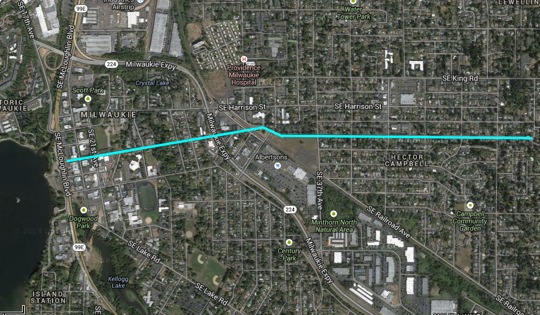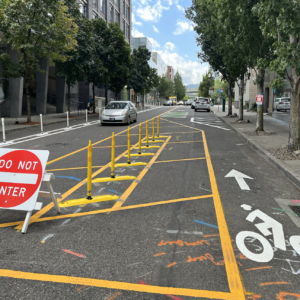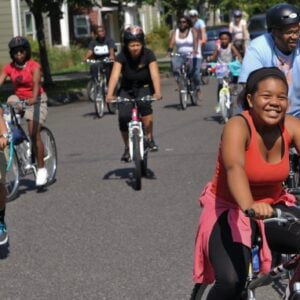
(Graphic: BTA)
Yesterday, the Oregon Department of Transportation announced the winners of their 2013 Transportation and Growth Management grants. Among them is a $103,000 award that will fund the planning and design of the Monroe Street Bike Boulevard/Neighborhood Greenway project.
While the dollar amount is relatively small, this grant represents a major milestone for Milwaukie, a city on the Willamette River just six miles south of downtown Portland.
The project has been a high priority for some Milwaukie residents since 2007 and it was the impetus behind the formation of Bike Milwaukie, a volunteer group aimed at getting people riding and engaged with bike issues. Matt Menely, a co-founder of that group, credits citizen activists who voiced support for the project as a key step in making this project a reality.
Earlier this year, the project also earned the attention of the Bicycle Transportation Alliance when it was chosen as a priority in their Blueprint report. The City of Milwaukie is also behind the project. It’s identified as a high priority in the City’s Transportation System Plan (TSP). In their application for the project, the City wrote that Monroe is a “key east-west bicycle route across the City and also important for pedestrians as a connection through several neighborhoods and downtown Milwaukie.” The City also wants to make changes to Monroe Street in order to “increase non-vehicular options for residents.”
The BTA is advocating for the project because Monroe is parallel to busy SE King Street and it connects directly to destinations on 82nd Avenue, a MAX station and the I-205 bike path. “With neighborhood greenway treatments,” writes the BTA, “Monroe could become the much needed east-west route for families and less-experienced riders.”

In just over two miles, the Monroe project would connect five of Milwaukie’s seven neighborhoods stretching from the Willamette riverfront, through downtown, and east to the Linwood neighborhood. “It can really bring the town together,” said Bike Milwaukie’s Menely, “it connects the east side where people live to the west side where the river, library, farmer’s market, high school, and all the other destinations are.”
This grant won’t fund construction, but it will do something just as important: Allow city staff to begin a conversation with Milwaukie residents about what a neighborhood greenway is and how it will make a positive impact on the city.
Milwaukie City Councilor Mark Gamba is a daily bike rider who has been a key champion of the project. “It’s great,” he said today in an interview about the grant, “Older folks in the neighborhoods along Monroe have been concerned about the concept of the greenway, what it means, and how it will impact their lives. ‘Will it mean I can’t park in front of my house?’ they wonder. Having this money will allow us to go through a process with them that will help them understand they’ll get an end product that will make their lives better.”
Gamba says the Monroe project is also key because it will be the first significant on-street improvement in bicycling conditions Milwaukie has built. “And it’s only part of a system that we need to build,” he said, “there’s 3-4 other neighborhood greenways that we need to get in as well so that people can get around town on bikes.”
According to Gamba and Menely, a lack of information about neighborhood greenways among some residents has led to a lot of misunderstandings and misinformation. “Once we have one and people see that it’s making the neighborhood happy and not ruining people’s lives,” says Gamba, “it’ll be easier to get another one in.”
As for the prospects of funding construction of the project, that’s still down the road (it’s unknown how much it would cost to build, since the design hasn’t started yet). Gamba said he’d like the project to be part of a bond initiative currently being discussed at City Council. “The rest of council wants us to use the bonds to pay for our light rail debt,” he shared, “but I’m suggesting we should be doing a bunch of project citizens have been asking for, including the greenways.”






Thanks for reading.
BikePortland has served this community with independent community journalism since 2005. We rely on subscriptions from readers like you to survive. Your financial support is vital in keeping this valuable resource alive and well.
Please subscribe today to strengthen and expand our work.
“Once we have one and people see that it’s making the neighborhood happy and not ruining people’s lives,” says Gamba, “it’ll be easier to get another one in.”
Ummm.. there are over a dozen greenways in Portland and they can be visited in about 30 minutes from every Milwaukie household. Doesn’t seem like this should be so difficult to get people to understand what it’s like. I realize Milwaukie, as part of Clackamas County, prides itself on being different from Portland, but really.. this isn’t a big puzzle how neighborhood greenways work. I think a field trip is in order.
For Milwaukie residents, it *is* a big deal. Most of the residents drive, and a lot of them don’t spend time in Portland neighborhoods – their experience of Portland is largely limited to arterials.
BTW, Portland pretty much copied Milwaukie’s bike signage when they revised their signage to match the state standard. Both cities learn from each other.
Kudos to those who have been involved since the 2007 TSP Update – Mark Gamba was one of those residents, as was Matt Menely, Heather Andrews and many others. Also, well done to Brett Kelver, Ryan Marquardt, and former Milwaukie planner Katie Mangle, who got the ball rolling. This has been a long time in the making, and it will be great to see a Neighborhood Greenway on Monroe.
nice, Monroe is only a block over from my kid’s house…
Seattle came to Portland and visited our “next generation Greenways.”….now they are building them. It should be easier for Milwaukee, this is a lot of money for design for a two mile greenway so they should have plenty of money for out-reach and a few rides to some of our nicer ones.
“Portland creep”
Yes the “P word” as we called it in Vancouver.
This can be another critical mental barrier too…very common in jurisdictions surrounding Portland that many have moved too to “get away” from Portland and its ideas…even though they also seem to still work in Portland.
Best to find any examples in cities similar to Milwaukie, etc. if possible.
Yes local good examples of projects do make some of the public design process easier…as sometimes this ‘walk and talk’ during a field visit is the only way to break thru a mental barrier…but do not assume local residents, business owners, staff and council members have seen (or let alone comprehend) completed projects even in their neighboring backyard.
When I worked at the City (CoV), I was always amazed at how common it was for my staff and citizens to go around with mental blinders on as to changes in the transportation system and urban form…most folks do not take to time to sit and think about such things as it is always point A to point B UNLESS it is so fundamentally different that it slaps them in the face (converting an arterial to a road diet/ right sized, road closure, etc.).
Others just check their work thoughts at the door when they leave the office too…
Chris I that was my first thought too! As a former resident of Clackistan I can tell you such things are sorely needed! Good for the city of Millwaukie.
Hi Folks,
Bike Milwaukie just lead a ride last Sunday to two of Portland’s Neighborhood Greenways (SE Bush and the SE “80’s route). We specifically chose Bush St because it is very similar to Monroe in the sense that both of them have sections without sidewalks, and the allow on street parking. We invited all of the City Council, Planning Commission, City Staff and Neighborhood leaders and residents that we could. Only 11 folks show up including one City Planner and one City Council member and it was a good ride with healthy conversation about what similar projects could look like in Milwaukie. I am sure that there will be plenty of opportunities to take those who are interested into Portland to show them examples of what Monroe St. can look like as this planning process moves forward.
Milwaukie is an interesting town in the fact that it only has approx. 22K residents, has several large pieces of infrastructure that divide the city’s neighborhoods, and has a large number of streets with no sidewalks. Neighborhood Greenways in Milwaukie will likely have a different feel than many of those built in Portland and we can point to money and resources as the main reasons. But as we learned riding along Bush St. last weekend, small but significant improvements make a world of difference in safety and enjoyment for all street users. Let’s get it done.
We are excited to be moving forward with the Monroe planning process, and continuing to build a broad coalition of supporters for safer streets in Milwaukie for all residents and visitors alike.
Matt Menely & Greg Baartz-Bowman
Bike Milwaukie, co-organizers
You could do a basic greenway along there for $150 – $200 k. $130k seems like a lot for planning. The choices are limited. Start with rational goals, identify what’s possible and what’s easy to do (not usually the same), have an open house or two to narrow down the choices, and build it. All the bumps might cost $80,000. Sharrows another $25k. Some bike buttons and lanes at the busiest intersecitons, maybe another $12k. put the centerline on DNR so it doesn’t get put back.
What at first glance appears simple is often much more complex: The proposed route crosses a major expressway and two rail lines. It also goes through a downtown grid to cross a highway. While not as busy as King Road, the section from Oak to 37th sees a lot of traffic.
All of these issues will take time ($) to analyze, consider the impacts, work with the community, and to design appropriately. This should not be just slap some paint down and get riding. That’s how you get a shitty bike boulevard and pissed off residents.
How many have you done, Vinny? There’s not a lot of real estate to work with. You could plan to spend $500k, and wait 10 years to get something, but why?
The two major road crossings already have signals, so can be handled with approaching bike lanes and push buttons ($12 k total) for the cyclists to activate the signal request. The rail crossing east of 21st looks good, but could be improved (I would lobby the rail owner regarding bike safety liability issues). There is sufficient space on Campbell to get to the existing crossing of the rail at Oak with buffered bike lanes (maybe an all-way stop at Campbell/Oak). You could probably widen the sidewalk on Oak to make a shared use path from Campbell to Monroe. An additional all-way stop at 47th would fit nicely with the pattern already out there. A median barrier at Linwood is already envisioned. 11,500 feet of street is 37 speed bumps, and that’s if you use the closer spaced fire-friendly version. Removing centerline is expensive, but the double yellow out there is probably part of the speeding problems, if they exist, so letting them fade away is the least-cost solution – and speed bumps will practically eliminate the need for the centerline. I don’t see residents giving up on-street parking where they still have it, so shared use is the defacto solution.